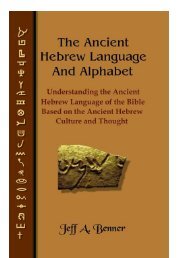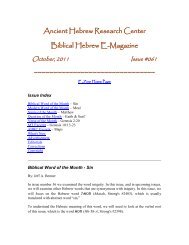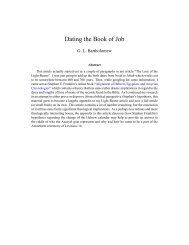My Name Forever - Ancient Hebrew Research Center
My Name Forever - Ancient Hebrew Research Center
My Name Forever - Ancient Hebrew Research Center
You also want an ePaper? Increase the reach of your titles
YUMPU automatically turns print PDFs into web optimized ePapers that Google loves.
<strong>My</strong> <strong>Name</strong> <strong>Forever</strong> 7<br />
18. The decline of <strong>Hebrew</strong> as a spoken language is thought to have begun with the fall of the<br />
Hasmonean dynasty and the rise of Herod to power in 63 B.C.E. A number of circumstances contributed<br />
to its final demise. Mr. Segal sums it up well.<br />
The destruction of many of the native families in the bloody wars which accompanied the<br />
coming of the Romans and the establishment of the Herodians (whose original language<br />
was probably Aram.); the closer connexion between Jerusalem and the Aram. Jewries of<br />
Syria and the Eastern Diaspora which followed on the incorporation of Palestine in the<br />
Roman Empire; and the settlement of those Aram.-speaking Jews in Jerusalem, all tended<br />
to spread the use of Aram. at the expense of MH. But MH still remained a popular<br />
speech, as is testified by numerous passages in its literature... Finally, the destruction of<br />
Jewish life in Judea after the defeat of Bar Kokba (135 C.E.), and the establishment of the<br />
new Jewish centre in the Aram.-speaking Galilee, seem to have led to the disappearance<br />
of MH as a popular tongue. 24<br />
19. It appears that <strong>Hebrew</strong> remained a spoken tongue well into the fourth century. 25 As such, its mode<br />
of written communication (letters and vowel-letters) was more than adequate to facilitate understanding.<br />
As it fell into disuse by the masses, however, it became more and more difficult to decipher written texts.<br />
This problem became most acute in relation to the Tanakh. As use of the language diminished, the proper<br />
reading of the sacred scrolls increasingly came into question. How could the accepted reading of the text<br />
be maintained and perpetuated as the language slowly died? This was the challenge. Sometime in the<br />
sixth or seventh century C.E. a group of scribes rose to the occasion. They invented a set of vowel signs<br />
or "points" to accompany the consonants and preserve the "traditional" reading of the <strong>Hebrew</strong><br />
Scriptures. 26 They were placed within, above and below the letters of the text. 27<br />
Y’hvah vuvh and Y’hovah vu«vh<br />
20. Since Pharisaic “reform” dictated an outright ban on speaking the <strong>Name</strong> “according to the<br />
letters,” whenever the scribes encountered “vuvh” they inserted into it, with a slight modification, the<br />
vowels of the word Adonai hb«st (Lord). This was to signify to those who would read the text that Adonai<br />
hb«st was to be read instead. Depending on the edition of the Tanakh, this looks like Y’hvah vuvh or<br />
Y’hovah vu«vh. Now, the discerning student is going to notice right away that neither set of these vowels<br />
matches exactly the vowels under Adonai hb«st. Bear with me for just a few lines. I’ll try to make the<br />
reason as simple as possible.<br />
21. The first difference is in the vowels under the initial letter. Under the Yud h of Y’hvah vuvh and<br />
Y’hovah vu«vh is a Sh’va ( ). Under the Aleph t of Adonai hb«st is a Hataph Patach ( ). The difference in<br />
24 Segal: Grammar, p. 15.<br />
25 Segal: Grammar, p. 15, footnote 2.<br />
26 William Gesenius: <strong>Hebrew</strong> Grammar (Oxford, 1983), p. 37.<br />
27 The <strong>Hebrew</strong> Alephbet and basic vowels, according to the Sephardic pronunciation used in Israel today, are in Tables 1 and 2<br />
at the end of this article.






